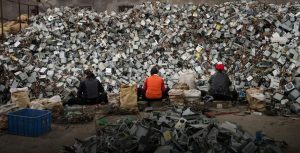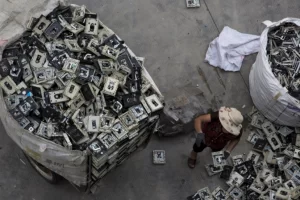Is this still where electronic devices travel from sorting containers?
Electronics recyclers are an important source of secondary raw materials for various industrial sectors, supplying ferrous metals, copper, aluminum, platinum, palladium and other safely extracted materials. Of course, once electronic devices and batteries are disposed of, they go a long way to being completely safely disposed of and secondary raw materials ready to be reused. However, in order for them to go this way and for electronic waste not to harm human health, it is essential that end-of-life electronic devices do not enter the black market but are disposed of in dedicated collection points.
 According to the Association of Electronics Distributors, the majority of collected electronic appliances consist of televisions, large household appliances such as washing machines, stoves, as well as appliances with refrigeration equipment – freezers, refrigerators. The path to disposing of unnecessary electronic devices begins with the right way to dispose of them – in containers for small electronics or batteries, or by registering the free removal of large devices from home.
According to the Association of Electronics Distributors, the majority of collected electronic appliances consist of televisions, large household appliances such as washing machines, stoves, as well as appliances with refrigeration equipment – freezers, refrigerators. The path to disposing of unnecessary electronic devices begins with the right way to dispose of them – in containers for small electronics or batteries, or by registering the free removal of large devices from home.
The management of e-waste (or e-waste) is one of the fastest growing pollution problems in the world. New technologies are rapidly replacing millions of similar devices, causing them to be dumped in designated electronic landfills, despite the potential negative impact on the environment. The constant emergence of new designs, “smart” features and technologies over the last 20 years is leading to the rapid aging of many electronic goods. Advances in electronics, attractive consumer design and marketing, and compatibility issues have significantly shortened the life of many electronic products. For example, the average lifespan of a new computer has dropped from 4.5 years in 1992. up to approximately 2 years in 2005 continues to decline, leading to an increase in the number of computers destined for removal or export. countries. Although it is difficult to quantify the amount of e-waste generated worldwide in the world, an overview of the amount of e-waste generated in China, Japan and the United States is available online, based on the available data for 1997-2010. Table 1). This report estimates that more than 130 million computers, monitors and televisions are obsolete every year and that the number is growing every year. 
The extraction of secondary raw materials saves the Earth’s resources during processing. The main loss to avoid a black market for electronic waste is the disproportionate damage to the environment compared to improperly mined precious metals.


